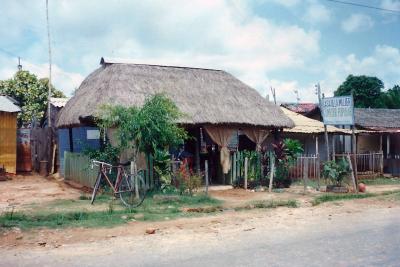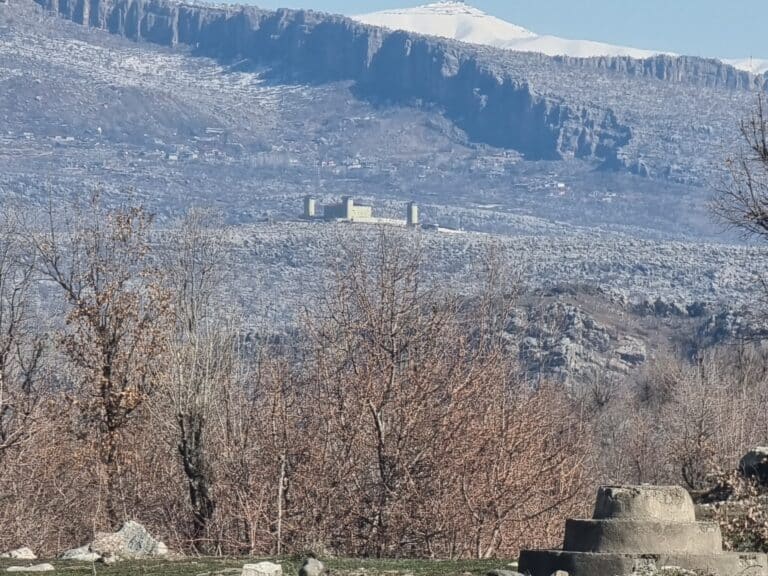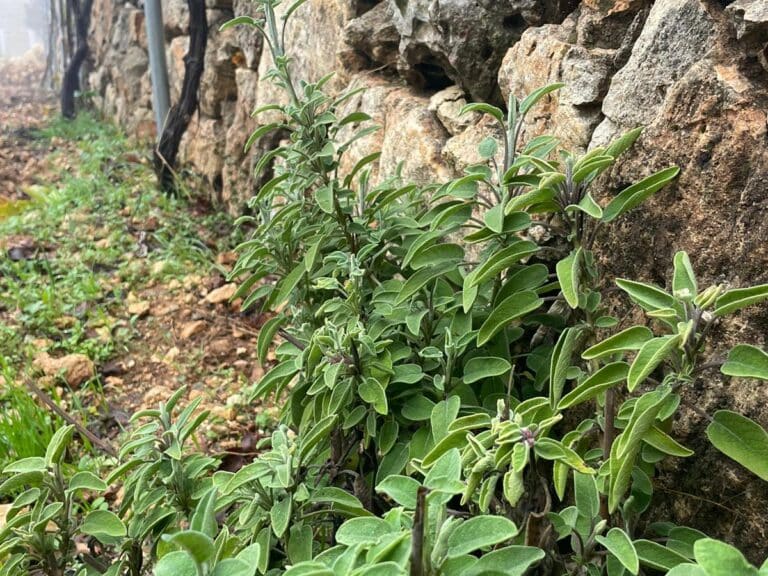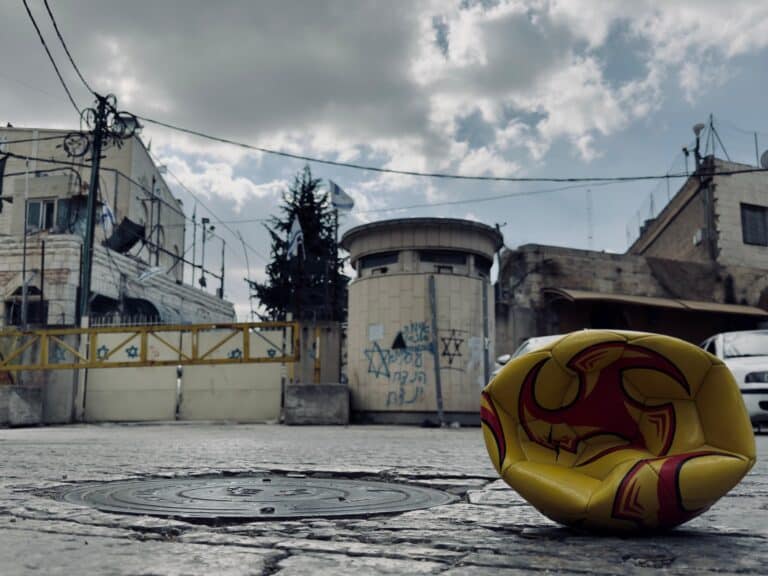translated to English by Jorge Eciso Harder
Those hands
A few years ago, I read an article about Palestine, complemented with impressive images. Among them, one particularly stuck in my head: the image of a pair of hands holding a key, communicating history. It was the wrinkled hands of Kafra, a 117-year-old grandmother; and the key she was holding was not just any key.
The horror for the land, over this land
In 1947 the United Nations arbitrarily divided Palestine in two, thus creating what is today known as Israel and what remains of the Palestinian territories. Very soon, by 1948, Israeli troops were violently charging into Palestinian land, destroying villages, stealing land and properties, forcing over 750,000 Palestinians into displacement. The Israeli military carried out more than seventy massacres, where approximately 15,000 people were murdered. This episode is known as the Nakba, an Arab word that means catastrophe, a systemic ethnic cleansing[1].
Families took with them whatever was at hand—the basics, the fundamentals, anything they deemed necessary for the road. Among this, something as basic as symbolic: the keys to their homes, reflecting the hope they had of coming back. But today, seventy-two years later, that dream is still unfulfilled, that right still ignored.
“When families depart, it’s those grandparents who had their children and whose children had children, and when those grandkids had children, so the family grows. If by 1948 there were 750,000 people, today we are more than seven million outside of Palestine who are denied our right to return,” says Jaldía Abubakra, a daughter of the Palestine diaspora that inhabits so many corners of the world but which remains rooted in its origins.
I know Jaldía in her activism; I respect her in her struggle; I accompany her in her denouncement. She is a founder of the Alkarama Movement of Palestinian Women, and in an exercise of memories and nostalgias, she tells me that her family was displaced in that Nakba of 1948. They were from Beersheba, a city located in the south of Palestine, but forcefully annexed by Israel.
The Israeli army invaded Beersheba, destroying a great deal of their territory and expelling all its Palestinian inhabitants to the Gaza Strip. They colonized the city and banned its people from returning. “I was born in Gaza; I’ve already been born with refugee status. Due to life circumstances, I had to leave and now I’ve been in Madrid, Spain, for many years. But I remain bound to my origins because it is essential that each of us, wherever we are born, be aware of our origins. That’s the key to returning, knowing where you come from so you can know where to return. That is our struggle: the return.
I listen to her while reminiscing the image of that grandma and her key…
I must confess that I never forgot that image. I printed it, I saved it, and I still have it. Because, how can you forget those hands? Those hands are familiar, those hands I’ve seen before, I’ve kissed before. This story that Jaldía tells, how can I not feel that story alive in me? Those are the stories of so many friends that I have known, who have shared their lives with me and who one day had to flee from the persecution of terror. That’s their story and the story of more than seven million internally displaced people as a consequence of the armed conflict in Colombia[2].
Such a distant Palestine, but such a familiar pain
It was 24 December when Gloria Amparo, human rights defender in Colombia and a member of the People’s Women Organization (OFP), received a call.
It was her neighbor calling, distressed, telling her, “Mamacita, be careful, mamacita get out of there, María has fifteen men in her house and they have her husband tied up, and Flor, the neighbor from the other side, is in the same situation and they have her son around the corner, get out of there, the paracos, mamacita, the paracos have invaded the neighbors’ homes, get out of there because they are going to hurt you and your kids.”
She relives the story, stirring up her sorrows. She tries to get me to time-travel with her, but I don’t know anymore if that terror was in Palestine or Colombia. But perhaps that is not relevant when you are talking about fleeing, about leaving your home.
“I took three bags, and the first thing I threw in was the Christmas gifts for my kids because it was the 24th. The other thing I put in was the new outfits for my kids, and then a few other things. Right then, my husband was returning home, back from buying groceries, he walked in, and I shut the door immediately and said: “Pedro, we have to go.” He looks at me and says, “What happened?” And I say, the paracos are here and here [pointing at neighboring houses]. We left on the motorbike, him holding a child in front and me with the other one, the three bags we had packed and the groceries.
“We attempted to come back, but the paramilitary commander of the area said he wouldn’t allow it, that it was our life or death, that we should choose. So we handed our house keys to a neighbor at a gas station and we asked him to pack everything up for us. Pedro went in with a truck the next day, at about six in the morning, like a thief, to empty out our own home and take everything. I never wanted to leave my house, it meant a lot to me, even if to others it wasn’t much. I loved the patio, because my kids were happy, without risks; that patio was their den. To me, it was the most beautiful palace, but I was never able to return,” sighs Gloria, calling on silence to contain the tears.
Following the route of the keys
Three years ago, following the route that the key had blazed, I found myself touring the Yasser Arafat Museum in Ramallah; yes, in Palestine itself. There I saw the historical keys that remember that Nakba, keys from other Kafras, of those other grandmothers, of those other stories. And this same path brought me to tour with Gloria The House Museum of Memory and Women’s Rights in Barrancabermeja, Colombia, a land that has known pain as well.
Immersed in a route of a thousand and one stories across the museum, I found what I came looking for, or perhaps, I prefer to believe, the story found me. It’s the story of the keys of the women of the OFP. To be honest, I never imagined I would stand at a museum in front of another set of keys that symbolize sadness, but also struggles that refuse to die.

Yasser Arafat Museum, Palestine 2017. Marcela Cárdenas 
House Museum of Memory and Women’s Rights, Colombia 2020, Marcela Cárdenas
The keys or the house
“On the morning of 27 January 2001, the paracos arrived at the [OFP’s] House for Women asking for the keys. The women that were there said they did not have the keys, that the coordinator had the keys, so they gave us until one o’clock in the afternoon to leave the house and hand over the keys because they wanted that house.”
That same day the paramilitaries gave the people of the Pablo Acuña neighbourhood two hours to leave their homes or otherwise be murdered. What these paramilitaries could never have fathomed was that at three o’clock in the afternoon when the house was supposed to be empty—the same house that had a community diner, that offered music and art workshops for the youth, that trained low income women—that same house, at exactly that time, would convert into a humanitarian refuge housing eighteen families, more than a hundred people with the contents of their homes, including dogs, cats and chickens. So the house takes another dimension, and the women decide not to hand over the keys.
But (there’s always an annoying “but”), “because we didn’t hand over the keys, we started to receive threats, saying that they were going to bomb the house, and they did come shooting around the house to scare the people. We took turns to stand guard along with the international organizations that were supporting us, and we resisted.”
Another house, another destiny
11 November 2001 came and, “The lady that helped me with childcare called and said, “Gloria, they stole the House for Women.” I asked her, “Did the thieves come in to rob?” and she said, “No, they stole it, they took it all.” And I told her, “María, I don’t understand, what do you mean?” She tried to explain, “Gloria, they took it, we didn’t sleep, all night long they hammered it down, even my husband could not come home and had to stay somewhere else because he was not allowed to come into the neighbourhood, they stole the house.” But even, then I couldn’t understand.”
Gloria went with other women to see what had happened and—of course!—how was Gloria going to understand, or even imagine that more than 30 men came and demolished the house overnight with picks and shovels. They even took the rubble, not leaving anything except the water pipe and the thatch roof that was left on the floor. They destroyed everything, gathered everything together, and took everything.
As a consequence of this, the OFP started the keys campaign, which declares:
My body is my house, my house is my territory. I do not hand over the keys.
Keys are for life, for peace, and not for projects of death.

OFP Archive: The House for Women in the north zone, before and after being destroyed by paramilitaries, 2001 
The museums: memories, struggles and legacies
When a physical structure is destroyed, the intention is to erase all traces of existence, end life, vanish the truth, stop the fight, and fill with fear to drown out hope. But in the resistance, you realize the real substance is not in the foundations or the concrete. What held that home together in its essence was the struggles that continue, even if all that’s physically left are the keys in the museums.
Like museums, stories are not there to create parallel universes, nor to tell distant and foreign realities; they are made to weave lives together, to connect collective memory in a fight against oblivion. To me, these museums preserve the lived memory, the evidence of strength used to fight, and the permanent effort to inherit the legacies.
The keys will then rest in the museums, but the struggles will remain alive beyond their doors.

Yasser Arafat Museum, Palestine 2017. Marcela Cárdenas. 

House Museum of Memory and Women’s Rights, Colombia 2020. OFP Archive. 
Symbolisms and more
“The key isn’t per se the material key; it’s the memories. When I am with my family, I intentionally sit with the elders to tell me how they lived on our land, about the traditions, about the landscape. We maintain our traditional Palestinian embroidery, the kiffiya, our way of speech, the dancing style, the old folklore songs that we continue to learn and write, so they don’t get lost. So the key is what you hold in your memory and that knowledge of your origins, because the key itself is not what will allow you to return, but rather the key is your struggle to return, all the work and the activism, that’s the key to returning.”
Indeed, these keys, now symbols of resistance, are not intended to open literal doors, but the doors of dignity and regaining the right to be and remain in that place where dreams have lived all these years. But this will not happen just because they have become symbols. To Gloria, for instance, symbolism must be accompanied “with conviction and love for what you believe in,” to which Jaldía adds that “they should be accompanied by constant work, a lot of patience, resistance and resilience.”
Historic legacies, their keys
Before saying goodbye to each one, I asked them what their own keys are as a historic inheritance because I am convinced of generational changes and the good road already plowed. Therefore, the wisdom of the women who fight has been and should be the legacy of those who want to inherit it.
Gloria’s legacy: “I leave the same thing I tell my kids, the teaching of love. Love for what we have, love for the land, the conviction of always acting accordingly with the disadvantaged, being just. Because things have meaning and are very important only if they serve others.”
Jaldía’s legacy: “The love for the struggle, the love for Palestine, the knowledge of our traditions, our culture, our civilization. I have hope in the young people, in generational learning and the knowledge that never ends.”
Even though they have never met, even though they have never embraced, the truth is that today we are reading each other. To our joy.
Here, two more stories of struggles that connect in sisterhood, and in so doing, they blur their borders.

Jaldía Abubakra Photo by: Mujer Palabra 

Gloria Amparo Suarez Photo by: Caldwell, 2017 
[1] Ilan Pappé, La limpieza étnica de Palestina; Crítica, Barcelona, 2008.
[2] ACNUR. “Hay más víctimas de desplazamiento forzado en Colombia que número de habitantes en Costa Rica”. December 26th, 2018; https://rb.gy/xrxkcq.



